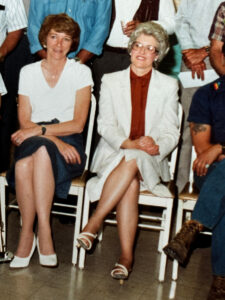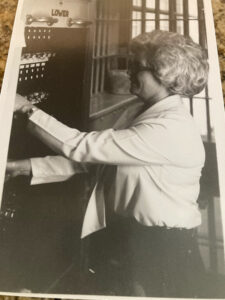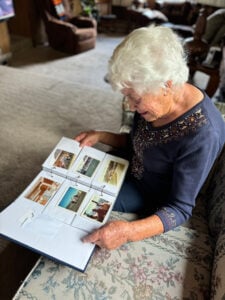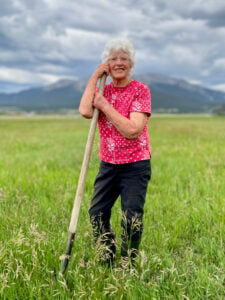Reflections on family and a fulfilling career at the Buena Vista Correctional Facility
Don’t ask Connie Hatfield if she’s ever planning to slow down. You’ll hear a resounding “no!” In many ways she’s even more busy today than when she worked full time, including nearly 30 years as a corrections officer at the Buena Vista Correctional Facility.
At 88, she’s still living a full life, walking six or so miles each day, and simply enjoying the surrounding scenery of the four Collegiate Peaks. She also keeps up with her adult children, her five grandchildren, and four great-grands.
As one of six siblings growing up in Jackson, Wyoming, Connie came from hardworking, determined, and industrious roots. Her dad’s side of the family — the Roberstons — pioneered the Jackson Valley; he did tradesman work and raised a few cows. Connie’s mom traveled alone by train to Jackson from Michigan when she was 13 years old to help with her sister’s family.
The family home had no electricity or running water until the 1950s. Connie’s mom built a fire each day to cook meals. And in the cold and unforgiving winters, Connie and her sisters slept in a feather bed huddled together to keep warm.
Her upbringing was rugged and unique. “We didn’t have much really, we were so darned poor,” she said. “Looking back, I guess you could say I’m glad we grew up that way, because we didn’t need anything. We were happy with what we had. We just learned to manage.”
After one year of college, Connie took a job as a clerk typist in Jackson at the Agriculture Stabilization and Conservation Service. Over the next few years she worked in the office at General Dynamics at Warren Air Force Base in Cheyenne.

Connie and her husband, Russell, met by chance in 1958 at the Log Cabin Dance Hall in Jackson, when he asked her to dance. A masonry contractor from Laramie, Russell was in town working on a construction project at the Jackson Airport. They married about 6 months later.
“Being from Colorado, Russell wanted to move back there, so in 1966 we settled in Buena Vista where we bought a 65-acre ranch,” she said. “This is such a beautiful part of the state; we just fell in love with it.”
“The ranch had a trailer where we lived until we built our house, and that’s where we raised our three children. It’s where I still live today.”
In 1967, Connie took a job as a secretary at the Buena Vista Correctional Facility, not knowing that she would stay there for the rest of her working life.
“Taking that job was probably one of the wisest decisions I made in my life, even though I didn’t realize it at the time,” she said. “At first I was just typing records and diagnostic reports, but within a few years I was talking to the inmates to write up their social histories.”
After several years, she and the only other female secretary were reclassified as sergeants. However, men in the prison system doing the same work were lieutenants.
“That said to me that this is a man’s world, because we were only sergeants. My friend and I appealed, but lost,” Connie said. “I just went back to my work and kept doing what I was doing.”
Several years later a lieutenant’s job came open, and she had a chance to have a job title that reflected her responsibilities. She and her friend both applied.
“I prayed about it, thought about it really hard because I wanted the job, but she was my friend. The day before the interview, I withdrew my name,” she said. “I knew she needed this job more than I did; I thought, ‘My day will come.’”
Later, Connie’s responsibilities broadened to handle case management, inmate supervision, plus assisting with work and vocational assignments.

“As a case manager, I had a caseload of more than a hundred inmates,” she said. “It was my responsibility to call them to my office if they filled out a request to see me and make suggestions to their problems. Sometimes it was issues with other inmates, family problems, work assignments, and other staff.”
If an inmate didn’t request a visit with her each month, she would initiate a meeting just to see how things were going.
She had to keep track of all the inmates and write up prisoners for various infractions including alcohol in their cells, rowdy behavior, or refusals to follow the rules.
“One of the first days I worked in the cellblock, I smelled jack — alcohol — coming from one of the cells, so I told a lieutenant about it. He took a walk but said he didn’t smell anything until he opened up the empty cell and saw the brew in the wastebasket.”
“When the inmates returned to their cells later, one of them found out what had happened and confronted me: ‘Who’s your snitch?’ he asked. My response: I pointed at my nose and said, ‘See this? I don’t need a snitch.’ I wrote up my first report that morning.”
Time and again, she said, she was tested by various prisoners. “It was their way of dealing with having a female in this kind of job, but I always stood my ground. I was 5 foot, 2 inches tall and weighed 115 pounds. My size could have put me at a disadvantage, but I didn’t let it.”
Connie said she couldn’t be scared to work in the cell block, because she’d been working at the prison for more than a dozen years already. Her attitude, her sense of humor, and her outlook kept her safe. “I could break up a fight better than the men on staff, and it only took one time to prove it,” she said, smiling.
“Once, two inmates got into a fight. As I got between them to break it up, I yelled, ‘You guys, knock it off,’” and I heard another inmate say, ‘Don’t hit the lady.’”
“It was up to me to break up the fight and handle the situation, so I locked one of them in his cell and told the other one to go down and wait by the desk. Then I got him locked in his cell. By then, the intervening inmate had already gone back to his with no problem.”
One day as inmates were returning from lunch, she was knocked down when an inmate jumped her.
“It made a lot of noise and could have been a problem,” she recalled. “Coincidentally, I had taken sexual assault training the day before — and while this wasn’t that kind of situation, I had learned that by grabbing a finger and bending it back as hard as possible, you can get anyone to do just about anything. It worked.”
“I couldn’t believe how many inmates came to me afterwards to apologize for that one inmate’s actions.”
Connie said she’s a big believer in giving people the benefit of the doubt and having patience. It paid off. In 1984, another opening came up for a lieutenant case manager; Connie’s name was at the top of the list.
“I’d done well on the written test, but the actual verbal interview was a bit tougher. So I just sat down and wrote up my history: I’d gone to college and earned my two-year degree in corrections, taken many classes, and undergone all kinds of training to keep up with the changes over the past 18 years. I had been doing case work from the beginning of my time there, and I had done a good job,” she said matter-of-factly. “I got the job.”
Connie remained in that role until she retired in 1994 from her job after 27 years of service.
She looks back on that time with mixed emotions.

She said there were plenty of times when she was in those cellblocks and inmates would sit beside her desk and talk with her. “I’d just listen, and I think that’s all they really needed — someone to pay attention to them and actually hear them.”
Connie recalled some of the things they said to her over the years. One young inmate was from a very wealthy family in Colorado Springs. He worked as her clerk and wanted to know why he had to wear orange when he went to court. “I explained to him that he was an inmate and that’s how it’s done. His reply? ‘I never thought I’d learn anything from a little old gray-haired lady in prison.’”
Another inmate told her she was the funniest person he knew. She said they always called her Mrs. Hatfield. “I knew — and they knew — that I had the upper hand, but I was never too forceful.”
“I hope they learned from me because I certainly learned from them over the years.”
Does she have any regrets?
“The bad thing is that you never really know what happened to those inmates. I just hope they have made a good life,” she said.
In addition to her career at the prison, she worked side by side with Russell both in his masonry business and in raising registered cows; she handled paperwork and keeping all the records.
I hope they learned from me because I certainly learned from them over the years. The bad thing is that you never really know what happened to those inmates. I just hope they have made a good life.” — Connie Hatfield
“He kept telling me to retire,” she said. “About five years after I did, he just decided to sell all the cattle and buy a truck big enough to pull a fifth wheel.”
They traveled in the fifth wheel back and forth from Buena Vista to Tonto Basin, Arizona, in the winter, later purchasing a park model there.
Russell died in 2011. She continued to travel back and forth to Arizona for about 10 more years.
When she talks about Russell, her voice softens.

“We had a good married life together. He was a kind man, a good partner, a good dancer, and very good looking,” she recalled. “You could say that we were like bookends. He died just one week before our 53rd wedding anniversary. I sure have missed him.”
She sold the park model in Arizona to focus on life in Buena Vista. Her children, grandchildren, and great-grandchildren come to visit. Lunches with good friends and weekly card games fill her time. She takes her long walks and reflects on her life.
“I’m thankful for the good life I’ve had and the people in it,” Connie said softly. “I’ve made good choices and am glad for the way things have turned out.”
Pamela A. Keene writes personality profiles, and lifestyle, gardening, travel, health care, and consumer articles. She is an avid gardener, has visited seven continents, and is an award-winning photographer.










